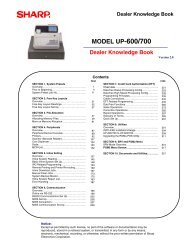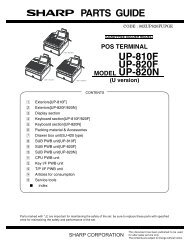ER-A Model - MS Cash Drawer
ER-A Model - MS Cash Drawer
ER-A Model - MS Cash Drawer
Create successful ePaper yourself
Turn your PDF publications into a flip-book with our unique Google optimized e-Paper software.
DOCUMENT<br />
POS/Glossary<br />
Term Definition<br />
Application Program This is the program for a particular customer<br />
Auto keys are used to automate or assign operations or functions to a<br />
single key. Auto keys allow for programming of several keys to a<br />
Auto Key Function<br />
single key. For example, a $20.00 speed tender, a Z Report or Tax<br />
Delete operation.<br />
BOGO Buy One Get One promotion.<br />
This amount is the “amount” of cash that should be in the drawer. It<br />
<strong>Cash</strong> In <strong>Drawer</strong> (CID)<br />
reflects paid outs, refunds, etc.<br />
Charge Posting/Customer<br />
Management<br />
Compulsory<br />
Condiment Tables<br />
Department<br />
Department Group<br />
FAT<br />
GLU<br />
This is an account record, such as a hotel / motel function or layaway<br />
which shows the current balance of an account. It reflects the charges<br />
and payments received to the account.<br />
This refers to a “Mandatory” function or procedure. E.g. “Compulsory<br />
drawer operation” means that the drawer has to be “Closed” for the<br />
machine to operate.<br />
The “condiment entry” is intended to guide the operator in making<br />
menu entries that require special instructions. E.g. chicken nuggets<br />
may be linked to a condiment table that will prompt for a choice of<br />
toppings (ranch, bleu cheese, honey mustard, none).<br />
This is a section of memory where the sales of items are stored. This<br />
total is updated on the fly. To see the amount of sales, an “X” (Read)<br />
or a “Z” (Zero out) report has to be taken. This category is named by<br />
the customer in PGM programming. E.g. “MEAT”, “PRODUCE”,<br />
“BE<strong>ER</strong>”, “CIGARETTES”.<br />
This is a section of memory where the departments are grouped and<br />
stored for reporting purposes. This total is updated on the fly. To see<br />
the amount of sales, an “X” (Read) or a “Z” (Zero out) report has to be<br />
taken.<br />
File Allocation Table: This is how we distribute the memory in a Sharp<br />
register where the memory is allocable. This allows “Files” to be<br />
different sizes depending on need. This allows better use of the<br />
memory available.<br />
Guest Look Up: This differs from a previous balance look up in that the<br />
GLU file holds an itemization of all registrations on the balance, while<br />
PBLU retains only the amount owed at the time of service.<br />
Inline or Inter-Register Communication: IRC is essentially a Local Area<br />
Network (LAN) consisting of Point Of Sale terminals, remote printers, a<br />
hub or switch, and possibly a personal computer. An IRC system<br />
IRC<br />
allows the manager to exercise centralized control over the satellite<br />
terminals through the master terminal. It is used to consolidate totals<br />
from one or more registers, to download programming, and sending<br />
information to a remote printer.<br />
Loop Reset This is a service reset.<br />
Sharp Electronics Corporation Sharp Academy 1 OF 5<br />
Page 103 of 108





